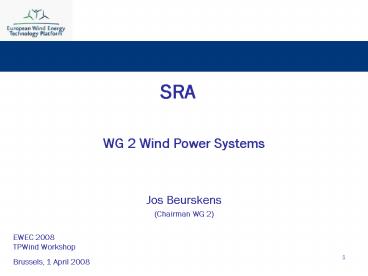WG 2 Wind Power Systems - PowerPoint PPT Presentation
1 / 17
Title:
WG 2 Wind Power Systems
Description:
New materials for many components such as blades and towers. ... Continuous control based on critical parameters, charactersing efficiency, ... – PowerPoint PPT presentation
Number of Views:31
Avg rating:3.0/5.0
Title: WG 2 Wind Power Systems
1
WG 2 Wind Power Systems
SRA
- Jos Beurskens
- (Chairman WG 2)
EWEC 2008TPWind Workshop Brussels, 1 April 2008
2
System boundaries WG 2
Manufacturing technology not addressed (yet)
WG 1
Transport, installation, OM on land only
3
Objective WG 2
Meeting the challenge of both maximising
reliability and realising technology break
through for meeting the ambitious wind energy
objectives by the European industry
4
Evolution innovation (revolution)
Reaching EU targets has enormous consequences for
sector in terms of
- Manufacturing capacity (up to 20 GW/year) 4
turbine/hour 12 blades/hour 50 switches/hour
several 100 sensors/hour, etc. - Availability of resources (people, concrete,
steel, copper etc.) - Reliability
- Grid connection speed
- Development of sites
To meet targets we need to realise the
consequences for manufacturing, reliability,
innovations.
5
RD
Incremental improvement
Innovation oriented research
Fundamental approach
6
Impact cost of energy more
COE Levelized Cost of Energy
(DKK/kWh) ICC Initial Capital Cost of project
(DKK) AEPNet Net Annual Energy Production
(kWh/yr) FCR Fixed Charge Rate (1/yr) AOE
Annual Operating Expenses (OM,
replacement, land)
7
Structuring RD into priority areas
Consider a wind turbine system as a
Flow device
Mechanicalstructure/Materials
Electricityplant
Controlledsystem
- OM/CM
Standards
RD facilities/Expertise/education
Concepts/Integration
8
Flow device
Structuring RD into priority areas
- With the increasing size and complexity of wind
turbines the need develops for - A full understanding of the aerodynamic
phenomena, including external conditions. - Significant improvement of the corresponding
design and analysis tools.
9
Mechanical structure/ materials
Structuring RD into priority areas
- Uncertainties need to be substantially decreased
to provide (component) manufacturers with
appropriate specifications for designing and
manufacturing. - Continued characterisation of both existing and
new materials to reduce design safety factors and
reduce cost. - Less uncertainties in materials characterisation
also requires improved measuring and evaluation
methods - New materials for many components such as blades
and towers. - Improvement of condition monitoring and system
control by incorporating sensors into the
materials. - Recycling of materials so that the quality of the
materials are maintained at original levels.
10
Electricity plant
Structuring RD into priority areas
- Improved high voltage power electronics to
increase efficiency and decrease costs. - Improved power converters to maximise system
efficiency, controllability and power quality. - Light weighted, low speed and low maintenance
generators, possibly including high temperature
super conductors (LT).
11
Controlled system
Structuring RD into priority areas
- Development of sensors to realise multi parameter
and adaptive control strategies, leading to
optimised operation. - Continuous control based on critical parameters,
charactersing efficiency, capacity factor,
safety, power quality, structural and electric
stability, while external conditions and turbine
properties may vary. - (Implementing these strategies would guarantee
low OM cost during the specified life time.)
12
OM CM
Structuring RD into priority areas
- Improving reliability by improving wind farm
management, reliability of wind turbine
components, and improve standardisation. - Minimising OM by cost applying preventive
maintenance strategies and tools developed on the
basis of low cost and extremely reliable
condition monitoring methods.
13
Concepts Integration
Structuring RD into priority areas
- Fully integrated methods (Design methods should
include all sub design routines such as those for
blades, power electronic stems, mechanical
transmission, support structures, transport and
installation loads, etc. After having been
developed they need thorough verification and
have to be introduced into the standard design
and certification processes.) (ref. UpWind) - New concepts will arise from innovations in
materials and components and from the needs of
the offshore project operators/owners. (Given the
huge challenges on the present and medium term
market, caused by the gap between demand and
supply, improving present wind turbine concepts
has to be addressed first and should not suffer
from conceiving disruptive technologies).
14
Standards
Structuring RD into priority areas
- Standardisation is the final stage of a
development trajectory it freezes the state of
the art knowledge. - In order to avoid that standards become a barrier
to technical innovation, the standards need to be
subject to a stepwise updating process. - All earlier mentioned aspects of technology
development will form inputs for the
standardisation process.
15
RD Facilities
Structuring RD into priority areas
- Joint efforts to realise facilities and to make
them accessible to the international RD
community and the wind turbine and component
manufacturers. (As wind turbines form large
structures most of the research infrastructure
needs to be large and costly as well. This
particularly applies to wind tunnels, blade
fatigue testing facilities, drive train testing,
wind turbine test stations and facilities to
evaluate wind farm control). - Need operational verification (demonstration) of
new risk full concepts such as new installation
and transport concepts. - Full scale (comparative) testing of wind turbines
under extreme climatological conditions provides
extra security for financiers planning large
investments. A joint operated test site at
extreme site would meet the need for such a
facility.
16
Interactions with other WGs
WG 1. WE Resource
WG 3. Integration
1
WG 2. Wind PowerSystems
WG 5. Market Economics
WG 4. Offshore
6
WG 6. Policy Environment
17
Thank you !

